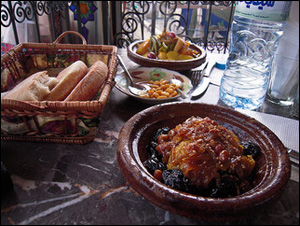 You would want the perfect holiday destination to have stunning natural beauty, interesting customs and exotic food. Morocco fits the bill in every way, especially in the food department, where all stages from selecting the freshest produce to its preparation, serving and savoring are all done with equally strong passion and flair.
You would want the perfect holiday destination to have stunning natural beauty, interesting customs and exotic food. Morocco fits the bill in every way, especially in the food department, where all stages from selecting the freshest produce to its preparation, serving and savoring are all done with equally strong passion and flair.
Having guests over for a meal is a matter of great pride for the average Moroccan. This tradition began in the royal courts, and the experimentation and creativity of their chefs led to the delicious Moroccan recipes which tourists from all over the world relish today.
The distinctive combination of sweet and savory is typical of Moroccan cooking, with the best example being the addition of fruits to meat dishes like the ‘tagine’. Its liberal use of spices subtly enhances the flavor and aroma of the food without being overbearing.
Morocco is an African country that lies in the Mediterranean belt, and has had Arabs, the Berber and Moor tribes from neighboring areas as its inhabitants for centuries. All these culinary influences beautifully blend together to make Morocco a food lover’s paradise.
What does a Moroccan lunch menu consist of?
A typical lunch here consists of several unique courses. You will start off with a variety of salads; some hot like the ‘taktouka’ that is made from tomato, green peppers and garlic, others cold like the ‘zaalouk’, consisting of aubergine and tomato. This is followed by a meat ‘tagine’, which is similar to a stew. Bread is an essential part of every meal and is freshly baked in all restaurants and households. Then you are served the famous ‘couscous’, made from semolina that is steamed to separate and puff up each grain, and topped with meat and vegetables. If there is a national dish of Morocco, this has to be it.
The Moroccan idea of dessert is any fresh, ripe and juicy fruit. However, they have some interesting sweets that you must try. ‘Kaab el Ghzal’ that translates to gazelle’s horns is a pastry filled with almond paste and topped with sugar. ‘Halwas Shebakia’ is made by deep-frying a small ball of dough, dipping it in honey while still hot and then rolling it in sesame seeds that stick to it; this is eaten during Ramadan, after the daily fasting period.
Exploring the food and drink habits in Morocco
A cup of green tea laced with mint stimulates digestion after this heavy meal or it can refresh and revitalize a person during the day. But it is much more than just a beverage in Morocco; it is considered an art form and a tradition. There is so much to learn, including the way it is poured! The long spouts of their teapots allow the tea to be poured from a height, thereby forming bubbles in the liquid. Add a lump or two of sugar as desired and sit back to enjoy each sip as you watch life go by in this mesmerizing place.
If you visit a Moroccan restaurant that has an authentic ambience, or if you are invited to a local household, you should be prepared to sit on cushions on the floor, with dinner served on a low table. Some dishes like couscous are traditionally served in one large platter that everybody at the table eats directly from, using their own spoons.
Non-vegetarian food lovers will enjoy Morocco
Being situated along the Atlantic coastline, Moroccan cuisine is not complete without seafood. High-end French restaurants have oysters, lobsters and other fishy delights on their menu. Moroccans liken fish to vegetarian food and usually include it in their salads, while meat forms the staple diet. Beef, chicken and the local favorite, lamb, are commonly used in tagines, grills, bocadillos and other meaty dishes. The latter is a type of sandwich borrowed from Spain, having a baguette filled with the meat and a salad, and is usually enjoyed with orange juice, the other favorite drink in this country, after mint tea.
Since Islam is the predominant religion in Morocco, pork and alcohol are banned here. But you won’t miss these items much, with the variety of other exquisite food that has you spoiled for choice. Supermarkets and restaurants in France and Britain are slowly stocking up on couscous, lamb tagines and other Moroccan fare, but you must make at least one trip to the paradise where these recipes originated. You will definitely want to go back again!
About the Author: Martin Boulton writes for medmelcome, a popular holiday rental website.
Credits: Photo courtesy of Michael Osmenda.